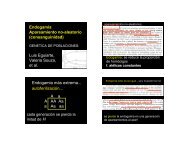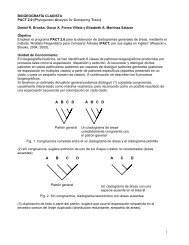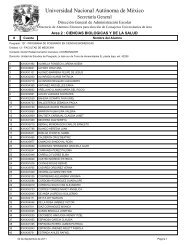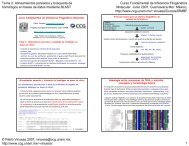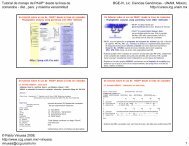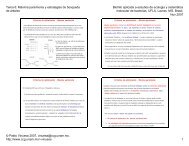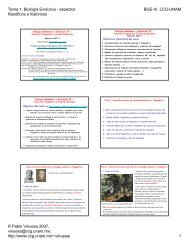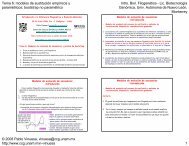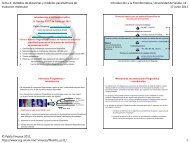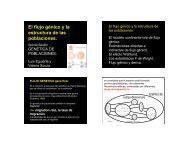<strong>Chromosome</strong> <strong>Structure</strong>nitrogen source. One key to efficient growth is control ofgene expression at the level ofRNA transcription. Theprocess ofmaking ofan RNA complement to a DNA geneis called transcription.To accommodate complex regulatory scenarios, chromosomesare divided into discrete transcriptional modulescalled operons. An operon has two functional components:the operator (or control region) and the coding sequence,which encodes the protein or RNA product. Althoughearly studies focused on operons such as lac, trp and his,which produce several proteins from a single operator,73% ofthe 2600 different E. coli operons encode only oneprotein. The operator includes at least one binding site forRNA polymerase, which is the enzyme that makes acomplementary RNA copy ofDNA. RNA polymerase hasa core subunit, plus a specificity factor called sigma (s).Sigma factors direct RNA polymerase to bind a specificsubset ofpromoters. In E. coli there are four sigma factors:s 70 , which controls many housekeeping genes and mostintermediary metabolism operons; s E , which is specific fornitrogen fixation genes; s S , which controls genes that areturned on in stationary phase; and fliA, which is specific forflagellar genes.In addition to RNA polymerase, promoters containboth positive and negative regulatory proteins. Negativeregulatory proteins are called repressors, and they blocktranscription by either impeding access ofRNA polymeraseor by inhibiting its ability to initiate RNA chains. TheLacI repressor blocks expression ofthe lactose genes whenno lactose is available for metabolism. There are alsopositively acting proteins called activators, which stimulateRNA polymerase transcription, either by stabilizing itsbinding to a promoter or by stimulating the ability ofRNApolymerase to initiate RNA chains. One example ofa wellcharacterizedactivator protein is the cyclic adenosinemonophosphate (cAMP)-binding protein (CAP), whichbinds to a large number ofoperator sites and stimulatestranscription when cAMP levels are high.In bacteria, replication and transcription can occursimultaneously. Replication requires all attached, doublestrand-specific DNA-binding proteins to be temporarilydisplaced during complementary strand unwinding andsynthesis. The proteins that have to be removed include thechromosome-associated proteins (see section on Chromatinabove), all repressors and operon activator proteins,and the RNA polymerase. Transcription presents a specialproblem for the replisome. Because transcription andreplication occur simultaneously, two situations arisewhere transcription machinery and replication machinerycollide. One case is where transcription and replicationmove in the same direction. Because a replisome pulls inDNA at 500 bp per second and RNA polymerasetranscribes DNA at 50 bp per second, replication forksrapidly overtake RNA polymerase, even when bothenzymes are headed in the same direction. The morestriking encounter occurs when DNA replication meets atranscribing RNA polymerase molecule moving oppositeto the direction ofreplication fork movement. In bothcases, the replisomes can pass RNA polymerases withoutcausing them to release transcripts or dissociate fromDNA. However, most highly transcribed genes aretranscribed in the same direction as replication forksmove. This includes all seven ofthe ribosomal RNAoperons (black arrowheads in Figure 2b) and 53 ofthe 86transfer RNA genes.In eukaryotic chromosomes, the RNA polymeraseresponsible for transcribing most genes is remarkablysimilar at the structural level to the E. coli RNApolymerase. However, regulatory mechanisms are different.Eukaryotic genes have a region called the promoterwhich is where RNA polymerase binds and startstranscription. However, polymerase binding and its abilityto initiate transcription is influenced by sites calledtranscription enhancers that can be upstream or downstreamofthe promoter (relative to the direction oftranscription). Enhancers act over very large distances,and so DNA looping is required to bring enhancers intocontact with RNA polymerase at promoters. In addition toenhancers, there are proteins called co-activators that mustbind to RNA polymerase to stimulate transcription. Whilethere are many questions about how co-activators work,one important known function is to modify histones byacetylating the H3 and H4 subunits.Recombination<strong>Chromosome</strong>s undergo three types ofgenetic recombination:homologous recombination, site-specific recombinationand transposition. Homologous recombinationinvolves exchanges between regions ofidentical or nearlyidentical sequences that are 300 bp or longer, with theefficiency ofrecombination increasing up to several kbp.Several repetitive sequences, including the seven copies ofthe ribosomal RNA operon in the E. coli genome, are largeenough to stimulate efficient recombination (Figure 2b). InE. coli, the pathway ofhomologous recombination iscarried out and regulated by four genes: recA, recB, recCand recD. Homologous recombination is responsible forthe introduction ofnew information into the bacterialgenome through mechanisms oftransformation, conjugationand transduction. However, another importantfunction of recombination is DNA repair. Recombinationallows replication forks that have stalled or fallen apart torestart DNA synthesis, in addition to allowing onedamaged chromosome to be repaired using informationfrom a sister chromosome. Thus, in addition to being anagent ofchange, recombination helps chromosomesremain the same.Homologous recombination is critical for repair ofDNA damage caused by chemical modification by8 ENCYCLOPEDIA OF LIFE SCIENCES / & 2001 Macmillan Publishers Ltd, Nature Publishing Group / www.els.net
<strong>Chromosome</strong> <strong>Structure</strong>alkylating agents, by ultraviolet light, and X-ray-inducedchromosome breaks. DNA damage is also caused byinternal oxygen metabolism, which generates free radicals.Replication errors also cause DNA breaks. The RecABCDpathway corrects a damaged copy ofa chromosome byusing identical sequences in a sister chromosome in thesame cell. As noted above, when rapid growth is underway,cells have more than one chromosome. RecA proteinserves two roles in repairing chromosome damage. First, itbinds to single-stranded regions ofa broken chromosomeand facilitates a search for the homologous sequence, andthen forms a hybrid molecule that starts recombination.RecA also regulates gene expression. When DNA damageoccurs, RecA protein inactivates a repressor called LexA,which results in the expression ofover a dozen DNA repairproteins. After DNA repair is complete, RecA proteinstops inactivating LexA repressor and DNA metabolismreturns to normal.Recombination is a critical repair pathway in mammalianchromosomes as well. Proteins that carry outbiochemical reactions similar to the E. coli RecABCsystem have been identified. A protein called p53coordinates the activity ofmany DNA repair proteins.Repair enzymes are stored at chromosome telomeres, andafter a signal from p53 these proteins migrate to sites ofDNA damage to restore chromosome function. Mutationsin DNA repair genes have been discovered to beresponsible for several human genetic syndromes thatresult in premature ageing and high spontaneous rates ofcancer.Chi SitesOne sequence in E. coli influences the efficiency anddirection ofrecombination: the chi sequence,GCTGGTGG. A chi site stimulates recombination directionally,by triggering the pairing ofchromosome sequencesnear chi. Like ter sites in replication, chi sites act inonly one direction. About 75% ofall chi sites are arrangedin the clockwise direction in replichore I and counterclockwisein replichore II, so that they instruct recombinationto proceed according to the direction ofDNAreplication.TransposonsTransposons are discrete genetic elements that move fromone site or from one chromosome to another, often withlittle regard to any specific DNA target sequence.Transposons sometimes carry with them genes forresistance to antibiotics such as tetracycline (Tn10) andkanamycin (Tn5). A transposon generally has invertedrepeats at the ends ofthe element, and encodes at least oneprotein called the transposase, which binds the ends andstimulates transposon movement. The chromosome of E.coli has 42 different transposons that have invaded byhorizontal transfer from other bacteria or viruses.In eukaryotes, transposons (usually called retrotransposonsbecause oftheir similarity to retroviruses and theirdependence on reverse transcriptase for replication) makeup a large fraction of total chromosomal DNA. In humancells, sequences called short interspersed nuclear elements(SINEs), which are about 300 bp long are present in about10 6 copies and represent 5% ofthe mass ofDNA in ahaploid genome. One particular SINE, called AluI, ispresent on average once every 5000 bp in every humanchromosome. There are also long interspersed nuclearelements (LINEs) ofabout 6 kb that are present in about10 5 copies and represent 15% ofthe haploid chromosomalmass. What function, if any, these sequences provide forthe host organism is questionable, but many geneticmutations have been attributed to gene disruption causedby recent transposon insertions.Site-specific RecombinationSite-specific recombination provides an efficient mechanismfor rearranging DNA at sites less than 100 bp in length(below the level required for homologous recombination).Site-specific recombination systems cause insertion andexcision ofdifferent lysogenic viruses, inversion ofregionsflanked by inverted sites, and deletions when two sites aredirectly repeated in a chromosome. Bacteriophage lcontains the best-studied site-specific recombination system– the Int/Xis system – which allows a prophage tointegrate into the bacterial chromosome at one point calledattB, or subsequently to excise and replicate in the lyticmode. Site-specific systems use a protein recombinase tobind and recombine short sequences, usually about 20 bplong.One site-specific recombination system in E. coli plays acrucial role in chromosome segregation. DNA synthesismay generate breaks (often on the discontinuous strand)that stimulate recombination between daughter chromosomes.Ifan odd number ofcrossovers occurs betweendaughters, the chromosomes will be dimerized at thecompletion ofDNA replication. In E. coli, about 15% ofthe normal replication cycles produce dimeric chromosomes.The site-specific recombination system that resolvesthese molecules is composed ofthe dif site at the terminus(Figure 2) and recombination proteins XerC and XerD,which efficiently separate daughter chromosomes justbefore cell division.In eukaryotes, site-specific recombination also has manycritical roles in biological development. One spectacularexample is the mammalian immune system, where differentchromosomal segments called V, D and J genes are cut andENCYCLOPEDIA OF LIFE SCIENCES / & 2001 Macmillan Publishers Ltd, Nature Publishing Group / www.els.net9



